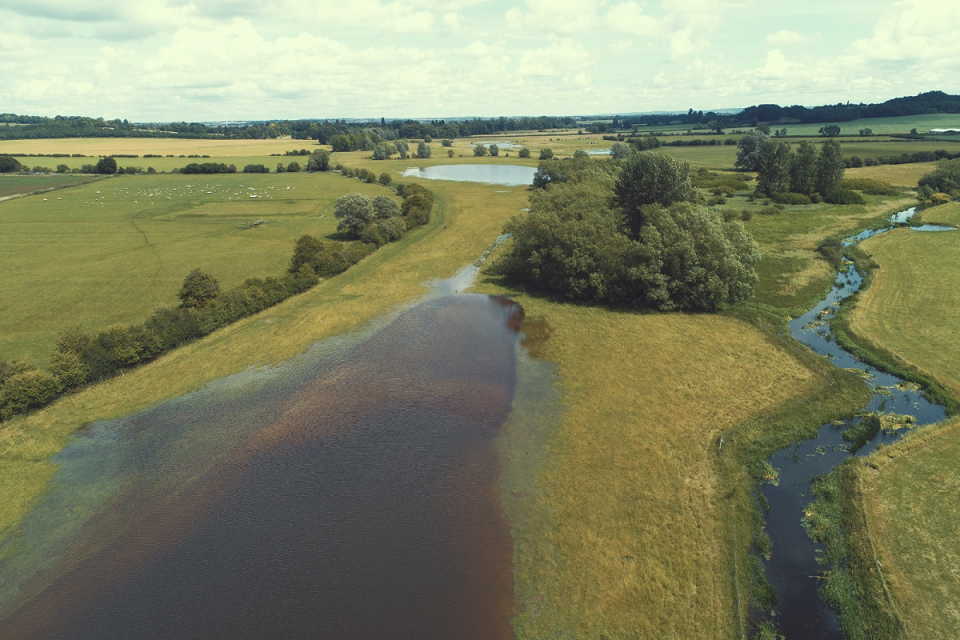As part of the international celebrations on World Wetlands Day, 2 February, local groups are making a remarkable difference to wildlife flourishing along the River Thame in Buckinghamshire - and showing what can be achieved when partners work together.
A combined 32 hectares of formerly low-biodiversity floodplain have been transformed thanks to the creation of new wetlands alongside the river - firstly on land at Eythrope owned and managed by the Waddesdon Estate, and followed by Manor Farm in Chearsley.
With a water environment grant of £360,450 from the Environment Agency, and expertise from the Freshwater Habitats Trust, at the Eythrope site, the River Thame Conservation Trust took on its first wetland and backwater construction project - and the biggest it had ever commissioned.
Work on the ground at Eythrope Wetland began 2 years ago, with the excavation of more than 11,000 square metres of polluted topsoil to clear the way for creating new wetland habitat at the 10-hectare site.
As well as a backwater - a large pond connected to the river, where young fish can safely grow to maturity - the project also created a variety of shapes and sizes of pools and scrapes, or dips in the ground that can fill with water. All these features encourage species of plants, insects and animals that thrive in wetland habitats.
The success of the project is evident in the wide range of species recorded at the site since its transformation. Regular surveys record excellent fish and bird populations, with 122 different species of bird using the wetland habitat in 2021, including teal, lapwing and ringed plover, among many others.
A key habitat for wetland birds, Eythrope Wetland is also an important stepping stone between two other wetland bird habitats in Buckinghamshire, near Aylesbury and Waterstock.

These vast wetlands near Aylesbury are now teeming with wildlife
While the Environment Agency supports many partnership projects improving local water environments, the site is the first of its kind in the Thame catchment.
Environment Agency project manager Anita Appleby said:
The Environment Agency is working hard to protect and enhance wetland habitats to benefit people and nature. Together with our partners, we hope that the Eythrope Wetland will become a site to evidence what can be achieved on a formerly low-diversity floodplain.
We also hope that the success of the project will lead to Eythrope Wetland receiving local wildlife site designation in 2023.
To help us adapt to a changing climate, the Environment Agency is also investing £120 million in replacing and restoring coastal habitat that will be lost due to rising sea levels. New habitat created as part of the programme not only improves coastal biodiversity but also acts as a carbon store and can provide natural flood and coastal protection.
Hilary Phillips, a senior project officer at the River Thame Conservation Trust, said:
The Eythrope Wetland project, completed in 2020, was a major milestone for us as a small grassroots charity working for a river catchment with healthy fresh waters and wildlife. It was the largest floodplain restoration project we had ever taken on and was the first of its kind in the Thame catchment.
We were able to transform a low-diversity 10-hectare meadow into a thriving mosaic of scrapes and pools to create a diverse wetland complex.
Hannah Worker, a senior project officer at the Freshwater Habitats Trust, said:
Although the project represents a new and innovative approach to wetland creation, it's actually quite a simple concept. We know that freshwater wildlife needs a variety of waterbodies, so by creating a complex of different clean water ponds and pools we can support a wider range of species.
Through collaborative projects like this, we're working with partners to build the Freshwater Network, a national network of wilder, cleaner, connected freshwaters to reverse the decline in freshwater biodiversity.
The success of Eythrope Wetland inspired similar work that took place earlier this year at Manor Farm in Chearsley, where again a backwater was constructed alongside the River Thame, along with scrapes and ponds, to create a wetland complex. While it is too early for the site to show results on the scale of the Eythrope Wetland, it is hoped and expected that it will develop along similar lines.
World Wetlands Day, celebrated annually on 2 February, aims to raise global awareness about the vital role of wetlands for people and planet. This day also marks the date of the adoption of the Convention on Wetlands on 2 February 1971, in the Iranian city of Ramsar.
Nearly 90% of the world's wetlands have been degraded since the 1700s, and we are losing wetlands 3 times faster than forests. Yet, wetlands are critically important ecosystems that contribute to biodiversity, climate mitigation and adaptation, freshwater availability, world economies, and more. To find our more, please visit: https://www.worldwetlandsday.org.
- Eythrope Wetland project partners were the River Thame Conservation Trust, the Freshwater Habitats Trust, Waddesdon Estates LLP, Aylesbury Vale District Council and the Environment Agency. Funding was provided by the European Agricultural Fund for Rural Development, Waddesdon Estates LLP and Thames Water, as well as from a water environment grant from the Environment Agency.
- Watch how the Eythrope landscape was created:
- Hilary Phillips, of the River Thame Conservation Trust, has written a guest blog for the Environment Agency, talking more about how floodplain restoration work was carried out at Eythrope and at Manor Farm, Chearsley: https://environmentagency.blog.gov.uk/2022/12/12/creating-new-wetland-habitats-on-the-river-thame-buckinghamshire/






